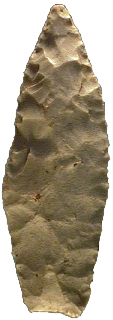

Point Type: SEDALIA
Also See: Agate Basin, Copena, Eden, Guilford, Lerma, Nebo Hill
Location: Midwestern United States
Associated Dates:
8000 - 5000 B.P.- Early Archaic
Morphology: Lanceolate
General Description: The Sedalia is a medium to large sized narrow lanceolate blade with straight to excurvate edges. There are three types of bases, straight, slightly concave or slightly convex. The straight variety seems to be more plentiful. Usually there is a slight constriction or tapering at the base. The typical Sedalia point is irregularly percussion flaked and then is finished with pressure retouching. The maximum width of the blade can often occur near the tip and the width is nearly one-third to one-fifth of the length. Some specimens exhibit slight recurvate blade edges near the base. Lateral grinding occurs on about one third of the specimens. The quality of flaking on the Sedalia is often times much cruder than on the similar Agate Basin point type and the Sedalia is much wider and not as thick as the Nebo Hill point type.
The size of the Sedalia can range from 76 mm to a huge 204 mm in length with the typical point being in the 150 mm range. The Sedalia type was named by R. M. Seelan in 1961 for specimens found near the town of Sedalia, Pettis County, Missouri.
About the Point Above: The small Sedalia point pictured at the top of this page, was a surface find near the town of Sedalia in Pettis County, Missouri. It is made from a light gray chert which has minute, round white and gray inclusions. It has a mildly convex base. Overall, the point measures 91 mm in length, is 29 mm wide (at 39 mm from the base) and is only 10 mm thick (mid blade at the point where the flutes end). The base measures 16 mm in width and the concavity of the base is 1 mm deep. The base is ground as are the blade edges running 17 mm up from the base. You will note that the left hand blade edge (the lower edge in the picture) has a larger edge chip or ding at almost mid blade. Catalog Number 62-39-C
References: Justice, Overstreet, Waldorf
© Copyright 1997 - 2008 LITHICS-Net WWW.LITHICSNET.COM
Use Your Browser's BACK Button to Return to the LITHICS-Net Index.